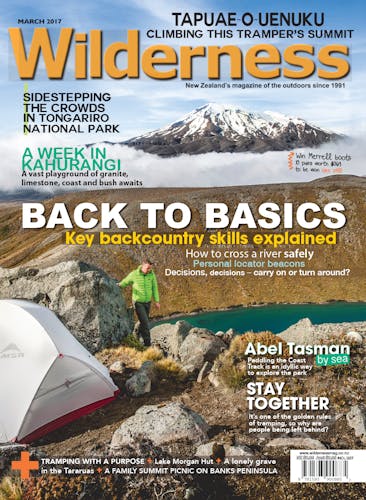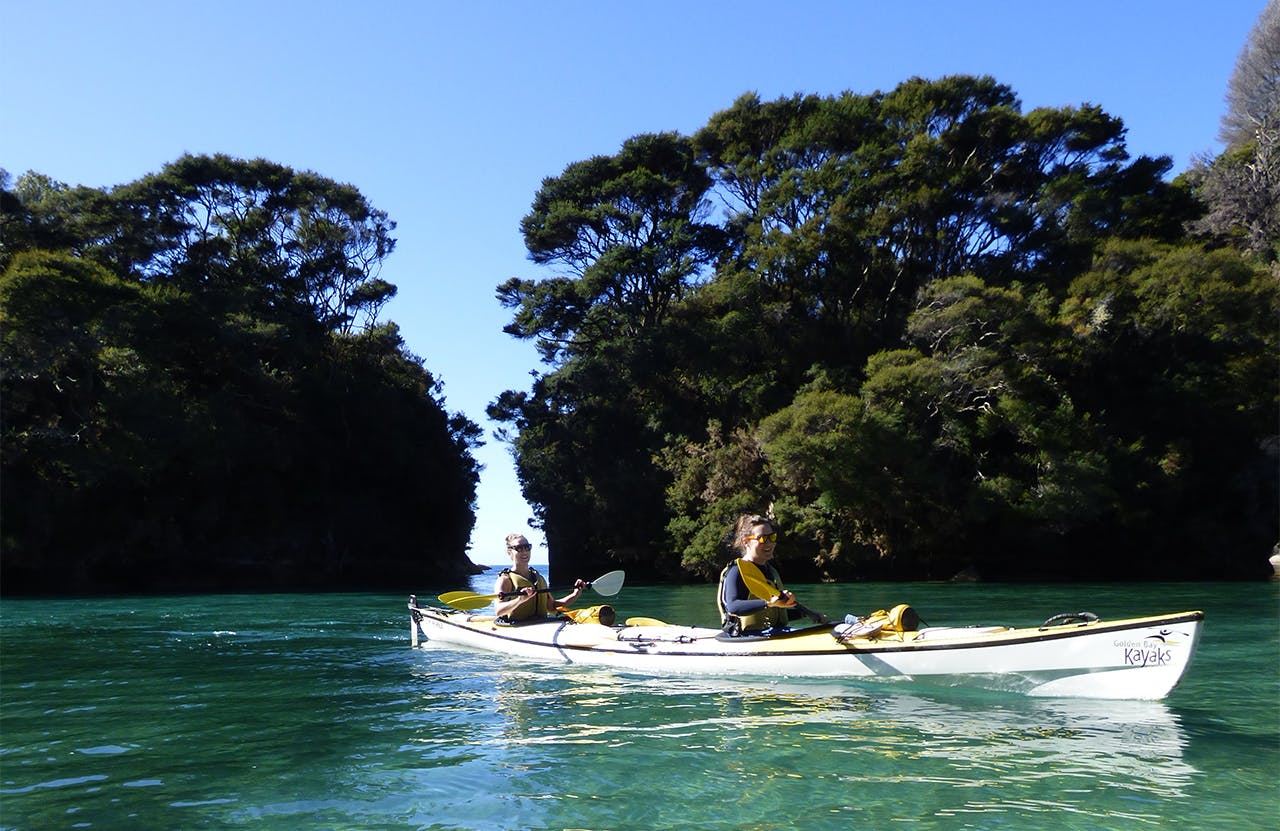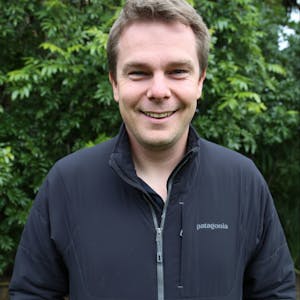- Time
- 3-5 days
- Grade
- Easy/Moderate
- Accom.
- Many campsites; Whariwharangi Hut ($32, 20 bunks); Awaroa Hut ($32, 26 bunks); Bark Bay Hut ($32, 34 bunks); Anchorage Hut ($32, 34 bunks). All must be booked in advance
- Access
- Tata Beach, 14km east of Takaka on Abel Tasman Drive
Is the reality of coming face to face with Abel Tasman National Park as good as it’s hyped up to be? Matthew Pike kayaks the full length of the park to find out
They say never meet your heroes. It’s impossible for them to live up to the hype, and the reality versus expectation is bound to disappoint.
In many ways, famous landmarks and trails take on a kind of celebrity status. You see pictures of them, you adore them, you often spend years imagining what it’s like to visit them.
In a few particularly geeky moments I’ve been starstruck, such as the time I momentarily stopped clambering through scree and thought to myself ‘Whoa, I’m actually climbing Mt Ngauruhoe! Yes, the Mt Ngauruhoe – the Hollywood star’.
Around the world the hype surrounding ‘celebrity’ landmarks can far exceed the experience, but I’ve found this to rarely be the case in this country. Sure, Fiordland in the rain can be disappointing, but rather than feeling you’ve met Charlie Sheen during his meltdown, it feels more like meeting Brendon McCullum when he has a hangover. He may appear irritable and short tempered at that moment, but ultimately you know he’s a bloody legend.
Which, believe it or not, brings us to Abel Tasman.This is one celebrity with bucket loads of hype. A glamour model which flaunts its curves to the world. Close your eyes and think of kayaking the Abel Tasman and your imagination is awash with lagoons, perfectly clear waters and the most glorious beaches.
Although I’ve met the Abel Tasman several times over the years, each time was fleeting and I never felt I’d got to know this stretch of coastline properly, experiencing its moods, both good and bad.
Arriving at Tata Beach close to the northern end of the park, I could have been mistaken for believing the Abel Tasman had had one too many the night before. A persistent wind smacked my face as I gazed towards threatening whitecaps and equally threatening clouds. The park was in a grump and didn’t want company today.
My plan had been to spend four days kayaking the full length of the park. It’s a trip many people I’ve spoken to would love to do, but comparatively few have actually done, which was why finding three friends to accompany me was easy. Neither Jason, Murielle nor Shaylin had been to the park before, so this moody encounter was their first experience of a region famed for its sunshine.
Four days in the park was to become three, but the forecast was good and we were eager to make the most of it.
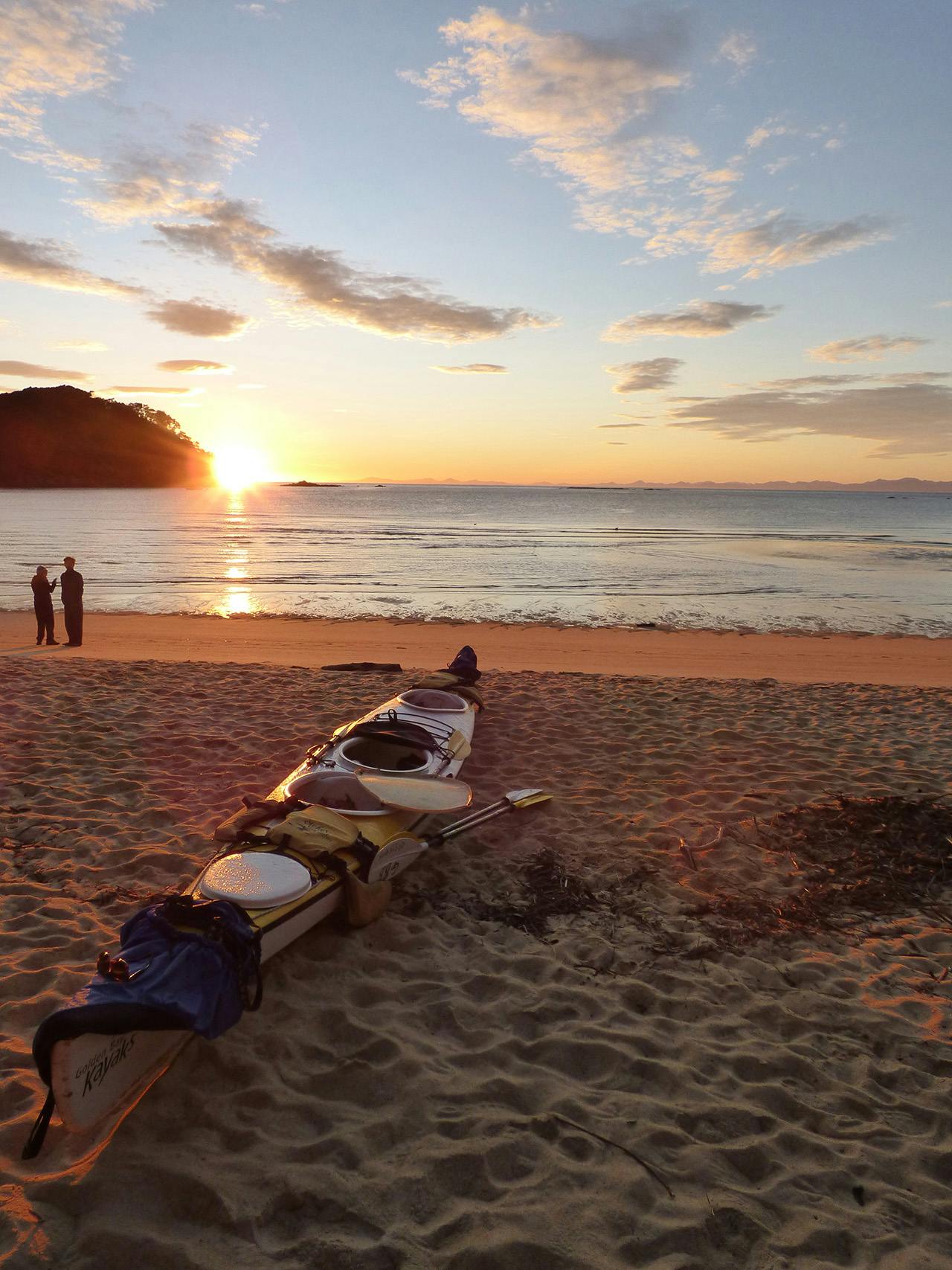
A beautiful sunrise at Bark Bay. Photo: Matthew Pike
Golden Bay Kayaks lent two of its boats to us. The company allows freedom kayakers to paddle the whole length of the park, so long as guides are happy you know what you’re doing after a thorough briefing.
One of the boats we were given was called Tiki, the other had the curious title of Fish Wobble.
In just a few minutes we were paddling past Tata Islands with the newly-risen sun warming our faces. The first stretch of coastline offers numerous rock formations to weave through, and sometimes under. The combination of arches and calm water enticed us to test our steering skills as we funnelled between the rocks.
Soon, the rocky cliffs give way to the broad expanse of Wainui Bay, where we shot straight past a mussel farm, aiming for Taupo Point at the far side. Rounding that small headland takes you to a fabulous little bay that, for us, signalled that we’d truly arrived in Abel Tasman. The beach is small, golden, sheltered and oddly bereft of sandflies.
After a quick stop primarily to delve into the enormous bags of scroggin we’d packed, we ventured on to Whariwharangi Bay. We took a short tour of the namesake hut, where we would have stayed had our journey started the day before as planned. I was a little sad not to have stayed there. I’ve not seen another hut quite like it; it’s an old and very scenic two-storey farmhouse with three bunkrooms, one of which only has two beds and another just four.
We were keen to get around Separation Point before any afternoon sea breeze stirred the water into a frenzy. Separation Point is where Golden Bay meets Tasman Bay and its exposure means rounding it can be dangerous when the wind picks up. But for us it couldn’t have been calmer – so much so that, rather than speed around the point as fast as we could, we spent ages bobbing in the gentle swell, watching the seals laze on the rocks and frolic in the water.
We continued past Mutton Cove and landed at the northern end of Anapai Bay for lunch. This is a smaller section of beach partitioned from the main stretch by a large rock, making us feel secluded. In fact, most of our first day felt secluded, as we passed just one kayak. The kayak companies to the south of the park don’t tend to venture north of Awaroa – our end point for the day – and the water taxis only travel as far north as Totaranui, which we were also yet to reach. It meant we had the ocean almost entirely to ourselves – a novel experience in such a popular place.
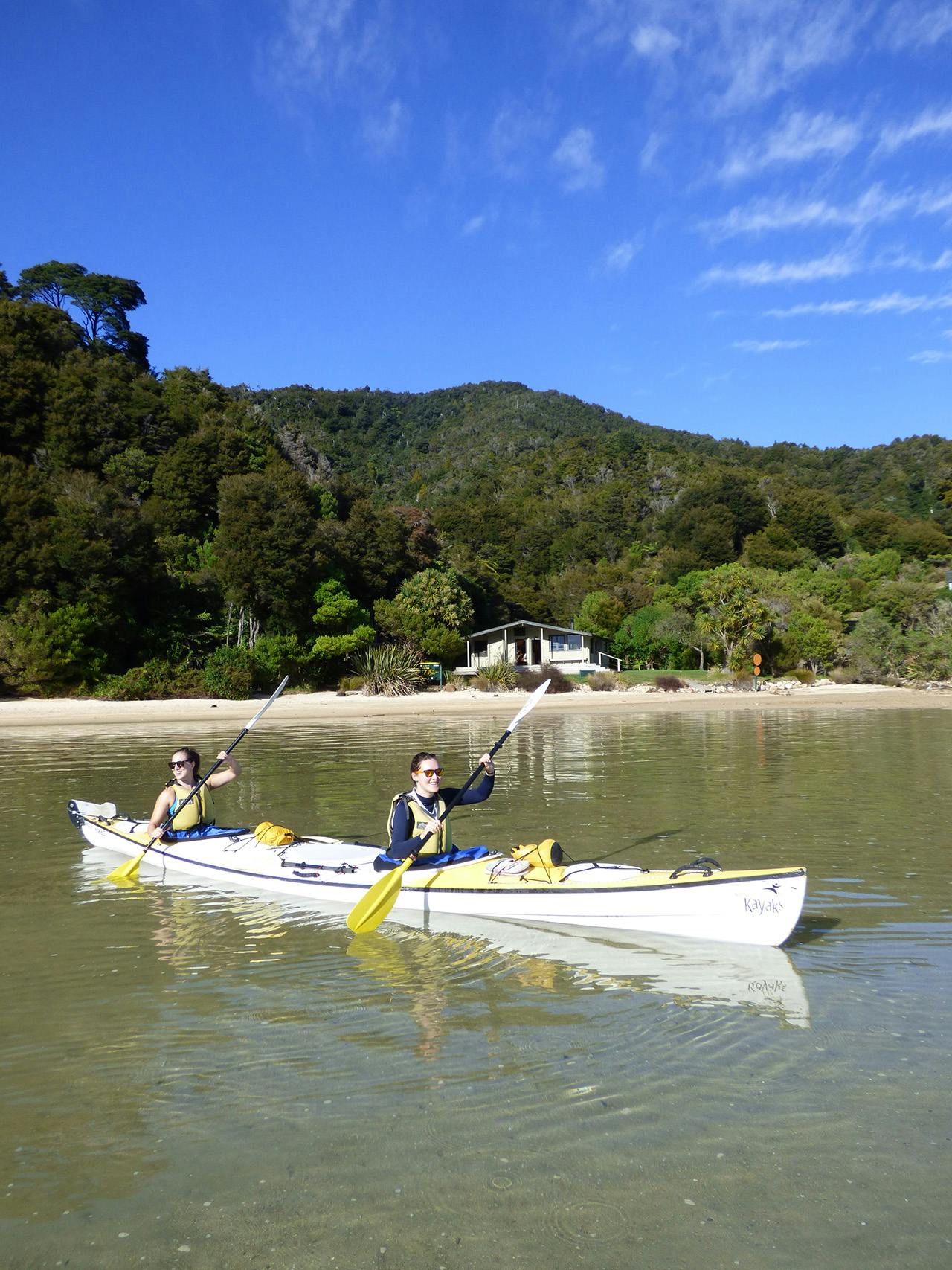
Leaving Awaroa Hut. Photo: Matthew Pike
This changed when we reached Totaranui and we saw water taxis dropping off and picking up from the boat ramp. Though the bay was beautiful, our group didn’t enjoy relaxing there as much as on previous bays due to the hustle and bustle. Admittedly, traffic was minimal and it was an enormous beach where avoiding people was easy, but we’d become spoilt.
Kayaking north to south gives you the opportunity to take advantage of the afternoon sea breezes we were keen to avoid at Separation Point. They also tend to head north to south in the warmer months and today’s breeze helped us coast to the entrance of Awaroa; a hugely picturesque estuary featuring swathes of sand which creates dramatic shadows in the evening light.
From here we expected a 15-minute trip up the estuary to Awaroa Hut. But it actually took 90 minutes, as I’d underestimated how much more difficult it would be to arrive at low tide.
The southerly showed no sign of abating. The water was frenetic.
It was like a jacuzzi into which Kim Dotcom had just jumped.
Firstly we went into the wrong channel, which soon petered out. Then, when we figured out which way to go, we battled our way upstream against the current and dragged the kayaks over the water once it had become too shallow to paddle. During this process a stingray glided past, terrifying a woman who was crossing the estuary on foot. She huddled close to us repeating that she didn’t like them and Steve Irwin was killed by one. For us, seeing it was a highlight.
When we came parallel to the hut, the fun really began. If you ever wish to test the mettle of your back, try carrying a fully-packed kayak 200m to the high tide mark. Then go back and carry the other one.
Needless to say, we were pretty exhausted and cold by the time we reached the hut. But we quickly got the fire going, the Milo on and the dehy bolognese ready, and it wasn’t long before we drifted off to sleep.
The early morning low tide meant the hut was almost empty by 7am. Awaroa is the major tidal crossing for walkers along the Coast Track. Get your timing wrong and it’s impassable. So all those heading north need to be away early before the water rises. We, by contrast, were happy to sit and wait. The sunrise was so beautiful that wandering around the estuary armed with a camera seemed far preferable to lugging the kayaks all the way back out to the channel. We’d wait for the water to come to us.
After powering our way out of the estuary against the current, we forwent a full English and a coffee at Awaroa Lodge to enjoy the delights of Shag Harbour at high tide. The journey there is along an impressive rocky coastline which took longer than expected to negotiate due to a surprising southerly that made conditions choppy.
Once in the shelter of the harbour, all was still. The narrow gullies are gentle havens from the elements, surrounded by small rocky cliffs and overhanging trees. It’s otherworldly. We let the tide drift us further into the harbour; our relaxation disturbed by a dark figure darting under the boat, followed by two more. They turned out to be seal pups and they weren’t alone. There must have been at least two dozen, playing together in small groups.
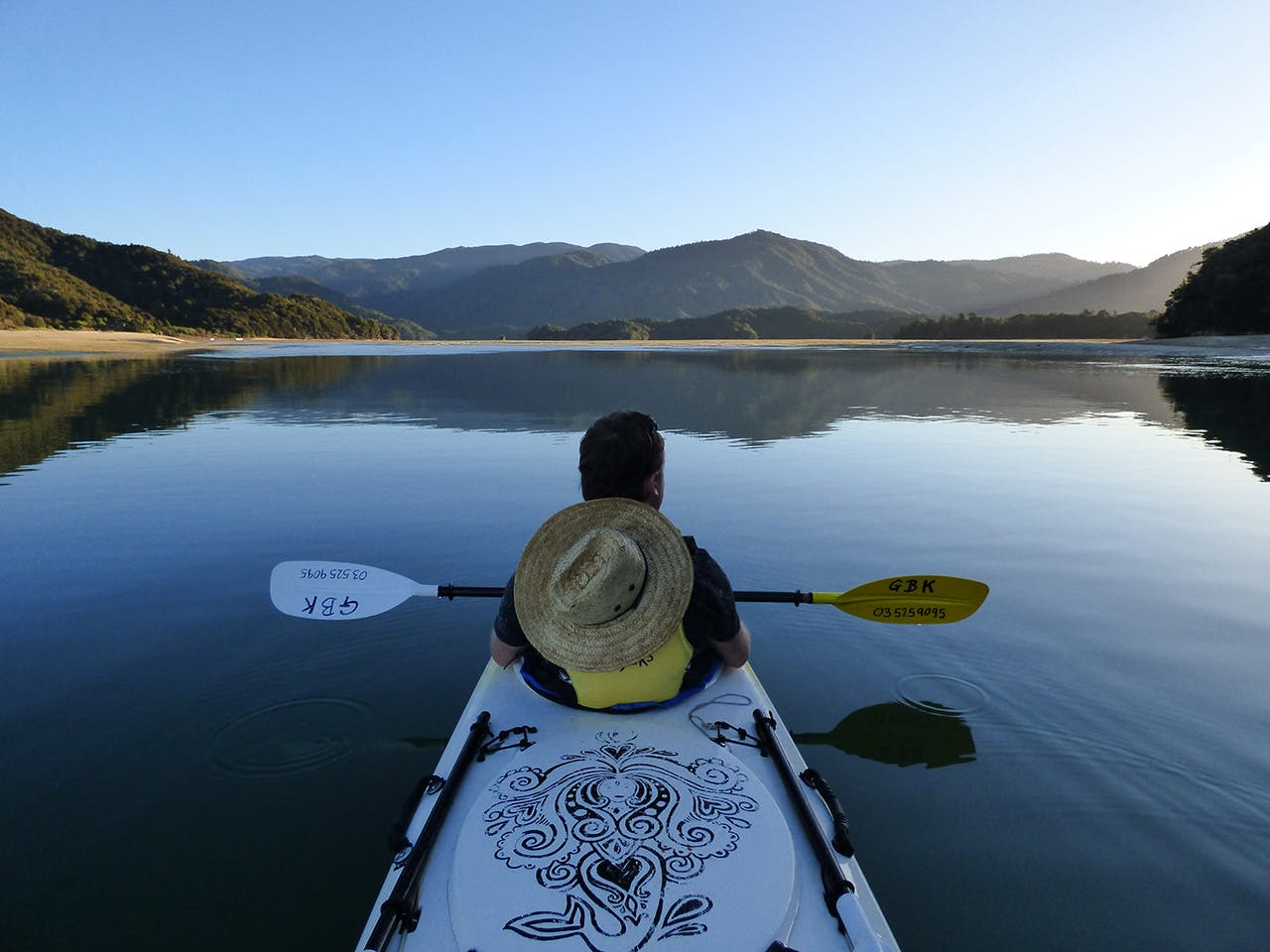
Enjoying the still waters of Awaroa Inlet. Photo: Matthew Pike
There’s something very special about a friendly interaction with a wild animal. And these pups provided the most enjoyable hour of our trip, popping their heads out of the water to check us out, biting the ends of our paddles, and occasionally daring a leap onto one of the boats. Some refer to seal pups as the dogs of the sea and after a trip to Shag Harbour at high tide, you understand why.
After leaving the harbour, we made a beeline for Tonga Quarry, passing Onetahuti Beach and Tonga Island (a protected island on which landing is not allowed). As the name suggests, Tonga Quarry was formerly used for its minerals, but is now a neat little campsite overlooking an attractive beach. After a long lunch and some shut-eye, we continued down the rocky coast, fighting the southerly, before stopping off at Mosquito Bay for a look around, then continuing to Bark Bay.
Both these bays have picturesque lagoons at high tide but by the time we reached them the tide was well and truly out. Both were idyllic settings, but I don’t believe we saw either at their best.
The same applied the following morning when we passed Sandfly and Frenchman bays; both offer scenic lagoon paddles at high tide – the creek at Sandfly Bay continues up-valley, passing under a Coast Track swingbridge – but we didn’t have time to wait for the tide. It reaffirmed my opinion that four days would be better than three, and five days better than four. This would give time to explore the bays and tracks, gaining a fuller experience of the park and enjoying the lagoons at their finest.
We made it to The Anchorage along gloriously glassy water far quicker than I’d anticipated. This is probably the busiest beach in the park, as many trips finish here resulting in a huge buzz around the place mid afternoon. In the early morning, though, it was serenely peaceful with just a gentle lapping of waves breaking the silence.
It was all perfect until one of the girls noticed an unnervingly large spider heading straight for one of our kayaks. It wasn’t much smaller than my hand and had distinctly tarantula-esque qualities. I was told later it was probably a trapdoor spider. Whatever it was, it wasn’t getting into our boat so we took this as our cue to leave.
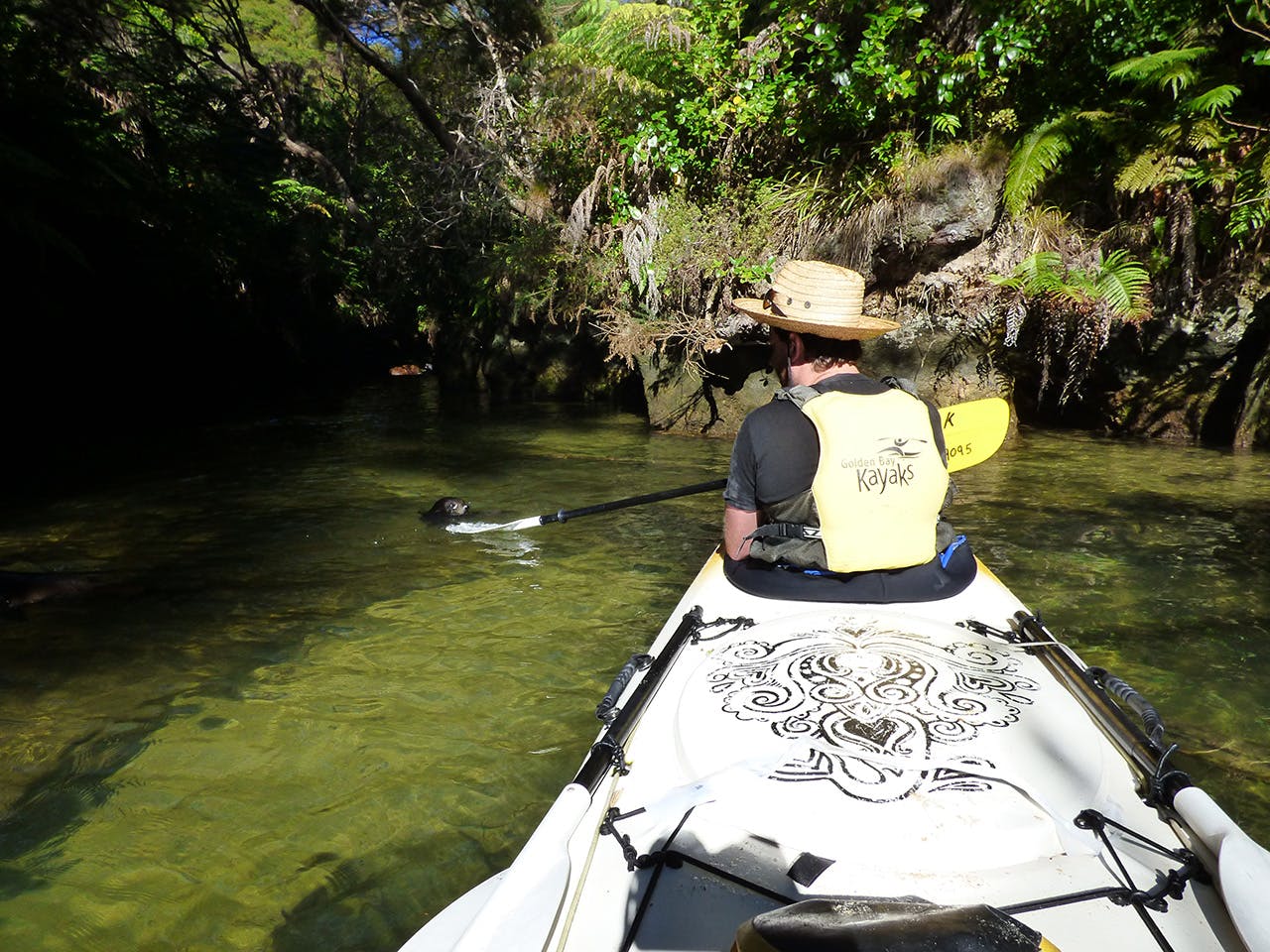
Playing with a seal pup in Shag Harbour. Photo: Matthew Pike
Once you leave the shelter of The Anchorage, you paddle around Pitt Head and from there is a stretch known as the Mad Mile, due to its exposure. In this case, the southerly that had pestered us yesterday had strengthened and we battled the chop and spray for some time, aiming for the relative shelter of Adele Island.
We reached a point where the wind no longer penetrated from behind the island, stopped paddling and relaxed, listening to the bellbirds singing proudly from the trees above. Throughout much of the park, the healthy quantity of birdsong is noticeable. But Adele Island is a clear step up from what we’d heard previously. There was little short of a symphony welcoming us to the island that day. All credit to Project Janszoon – its extensive conservation work seems to be paying dividends.
We parked on a rapidly disappearing beach, as the tide rose ever-higher. At one point, three seal pups swam on to the beach, had a quick look around, realised we weren’t very interesting, then sped off.
The southerly showed no sign of abating (unlike our beach) so we decided to head straight for Marahau. The water was frenetic. It was like a jacuzzi into which Kim Dotcom had just jumped. Each kayak would momentarily lose the other as it disappeared behind a wave, only to be lifted to a crest before the front end smacked down into the trough. It was great fun.
We arrived in Marahau with aching arms and covered in salt. We’d had three fine days, experiencing glassy calm and southerly chop, we’d played with seals, watched stingrays, paddled through narrow lagoons and archways. We’d experienced many moods of the Abel Tasman and had come out the other side proud to say this is one celebrity we’re pleased we got to know.
More photos from this trip…

















